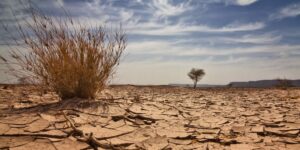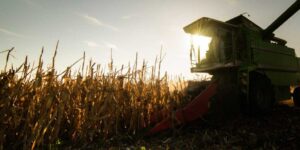Photosynthesis, under drought stress
Hamna Shazadee1, Sonia Zulfiqar1, Mahnoor Jamil1, Shakra Jamil2, Rahil Shahzad2
- Centre of Agricultural Biochemistry and Biotechnology, University of Agriculture Faislabad
- Agricultural Biotechnology Research Institute, AARI, Faisalabad.
Importance of water
Water is one of the most important substances which both plant and animal need for their survival. Plants require water for photosynthesis, nutrient uptake and transportation as well as cooling. Plants unlike the animals are unable to move when the environment becomes unfavorable. Accordingly, plants have to be able to respond and adapt to the environmental changes. Since water is very important for plant survival, therefore, the ability to tolerate water stress is crucial. Plants need to take up water from the soil and CO2 from the atmosphere and use it in photosynthesis, which is essential for their growth. CO2 uptake is done through the stomatal pore, where water is simultaneously transpired. This transpiration results in regulation of water uptake by the roots and transportation through the xylem. When the stomata are open CO2 enters inside while water is transpired. When the stomata are closed little CO2 is taken up and the transpiration rate is lowered. By this phenomenon of opening and closing the stomata, plants can regulate the amount of water lost, by sacrificing CO2 uptake, when the environmental conditions are unfavorable.
Water stress
Water stress is considered to be main environmental factor limiting plant growth and yield worldwide, especially in semi-arid areas. Drought is the most severe stress and the main cause of significant losses in growth, productivity of crop plants, and finally their yields. Drought affects morphological, physiological, biochemical and molecular processes in plants resulting in growth inhibition, stomata closure with consecutive reduction of transpiration, decrease in chlorophyll content and inhibition of photosynthesis and protein changes to cope with osmotic changes in their tissues.
When the water availability is reduced, plants change their biochemistry to be able to retain as much water as possible. During water stress plants produce and accumulate compatible solutes such as sugars, polyols and amino acid to lower the osmotic potential in the cells to facilitate water absorption and retention. Some of the compatible solutes also contribute to maintaining the conformation of macromolecules by preventing mis-folding or Denaturation.
However, of various physiological processes, the accumulation of a plant hormone, abscisic acid (ABA), has a vitally important role in the plant growth and metabolism under stress conditions. ABA is usually known as a stress hormone due to its high accumulation under stress conditions. One of the immediate responses to water stress is stomata closure, which is caused mainly due to the action of ABA.
The Light reactions of photosynthesis
Chloroplasts are the organelles which serve as site for photosynthesis. They convert light energy into chemical energy. Chloroplasts also participate in the amino acid, vitamin, isoprenoid and lipid biosynthesis, as well as reduction of nitrite and sulphate. The light-dependent reactions of photosynthesis use light energy to make two molecules needed for the next stage of photosynthesis: the energy storage molecule ATP and the reduced electron carrier NADPH. In plants, the light reactions take place in the thylakoid membranes of chloroplast.
Proteins involved in light reaction
There are approximately 3000 proteins in mature chloroplasts that have specialized distributions and functions. The thylakoid membrane contains some integral membrane protein complexes that catalyze the light reactions. There are four major protein complexes in the thylakoid membrane: Photosystem II (PSII), Cytochrome b6f complex, Photosystem I (PSI), and ATP synthase. These four complexes work together for the production of ATP and NADPH.
Chlorophyll binding proteins are synthesized in the cytoplasm and then they are imported to chloroplast where they are finally inserted in the thylakoid membrane. The chlorophyll binding proteins have multiple functions which include light harvesting, energy dissipation and pigment storage. As components of the light harvesting complexes in plants, the primary function of chlorophyll a/b binding proteins is the absorption of light and transfer of the excitation energy to the photochemical reaction centers. In some cases, plants are exposed to higher light intensities than used in photosynthesis. Therefore, in order to prevent photo inhibition and damage to the photosynthetic machinery, excess energy is then dissipated by the chlorophyll biding proteins. In this way, these proteins function in energy dissipation. In addition to these two functions, another important role played by chlorophyll a/b binding proteins is in pigment storage.
Photolysis of water occurs in the oxygen-evolving complex (OEC) of Photosystem II (PSII) reaction centers. The OEC is composed of four manganese ions, calcium and possibly chloride ions, which are bound to extrinsic proteins. Photosystem II OEC proteins are involved in retaining calcium and chloride ions, two inorganic cofactors for the water-splitting reaction. The oxygen evolving enhancer protein is believed to have a dual function; (i) optimizing the manganese cluster during photolysis and (ii) protecting the reaction centre proteins from damage by oxygen radical formed in light. Ferrodoxin-NADP oxidoreductases catalyse the reversible electron transfers between one electron carrier systems (ferrodoxin) and the two-electron carrying NADP (H) (Thomas et al., 2006). In chloroplasts, the main physiological function of this enzyme is to catalyze the final step of the photosynthetic electron transport, providing NADPH, which is then utilized in the carbon fixation step of the Calvin cycle Also, FNRs are involved in the photosynthetic machinery where electrons are transferred from ferredoxins or flavodoxins to NADPH and are also implicated in protection against ROS.
Effect of drought stress
Photosynthetic response to drought stress is highly complex.The drought stress mainly damages PSII of the photosynthetic organ of plants. As plants are exposed to water deficiency, the proteins which are involved in the Calvin cycle decrease. As a result of this decrease, the light energy which is absorbed through the photosynthetic pigments exceeds its rate of consumption in the Calvin cycle .This increased absorbed light energy causes damage to the photosynthetic machinery, particularly the photosystem II (PSII) reaction center core proteins D1 and 4D2.
Response to drought stress
Under the drought stress, the plants first close the stoma to reduce the transpiration and prevent the entry of CO2 into the leaves. The photosynthesis of the leaves is influenced by the stomatal and non-stomatal factors. Plants have evolved several mechanisms to avoid damage caused by increased light energy to the photosynthetic machinery. These mechanisms involve antenna modulations and decreasing the size of antennae to reduce the amount of absorbed light .As a response to drought stress, some changes also occur within the proteins of photosynthetic machinery i.e. impairment of oxygen evolving complex, which is involved in the stabilization of PSII complex, known as oxygen-evolving complex (OEC) proteins, prevents the damage to PSII complex caused by increased light energy. On the other hand, HCF136, a protein that is essential for the repair and assembly of the PSII complex decreased under drought stress. PSII can regulate actively the electron transport rate and the photochemical efficiency, as a response to the decrease of the CO2 assimilation capacity. It prevents or relieves the damage caused by excessive light energy to other systems via heat dissipation.
Calvin cycle:
Calvin cycle occurs in the stroma of chloroplast. These reactions do not need light directly that’s why also known as dark reactions. Basically Calvin cycle is the series of reactions by which carbon is fixed and reduced resulting in the formation of sugar during dark reactions of photosynthesis.
Calvin cycle is divided into three phases: carbon fixation, reduction and regeneration of carbon dioxide acceptor (RUBP). Depending upon the primary product of carbon fixation plants are classified into two categories: C3 plants and C4 plants. C3 species have oxaloacetate (3 carbon compound) as primary product of carbon fixation and C4 species have 3-phosphoglycerate (4 carbon compound) as primary product of carbon fixation.
Under normal conditions:
The first phase (carbon fixation) of Calvin cycle is catalyzed by an enzyme which is known as Rubisco. This enzyme plays a vital role in this series of reaction because without this enzyme carbon fixation is not initiated. Carbon fixation is started when RUBP (ribulose 1,5-bisphosphate) which is CO2 acceptor molecule accepts CO2 with the help of Rubisco and forms 6 carbon compound which is unstable and immediately breakdown into two molecules of 3-phosphoglycerate.
In reduction phase 3-phosphoglycerate is phosphorylated into 1, 3-bisphosphoglycerate. This is reduced into G3P (glyceraldehydes-3-phosphate). For every 3 molecules of CO2 entering the cycle and combining with 3 molecules of RUBP, six molecules of G3P are produced but only one molecule of G3P can be counted as a net gain of carbohydrate.
In the third phase RUBP molecules are regenerated to allow the first step to occur.
Under drought stress:
Under the deficiency of water, the CO2 concentration in leaves decreases due to stomata closure which results in decrease in the activities of enzymes involved in Calvin cycle. The key photosynthetic enzyme in plants is Rubisco which catalyses the carbon fixation. This enzyme is localized in chloroplast stroma. This enzyme has two subunits: Rubisco large subunit (RLS) which has catalytic activity and Rubisco small subunit (RSS) which has regulative function. The RLS is encoded by a single chloroplast gene while RSS is encoded by a small family of nuclear genes.
The correct folding of RLS requires chaperonin system consisting of Rubisco binding protein (RBP). Under drought stress these RBP contents are decreased due to which Rubisco large subunits are not correctly folded and are unable to perform their function. Secondly under drought conditions the RLS is itself down regulated by chloroplast in drought susceptible plants.
Generally drought induces metabolic changes related to protein turnover. For example Rubisco activate protein (RA) is a protein which is involved in the activity of Rubisco by removing tightly bound sugar phosphate from the active site of Rubisco. RA is not only a conventional enzyme but also belongs to a class of chaperone like proteins acting on other macromolecules and catalyzing mechanical processes.
Under drought stress the concentration of this RA protein is increased and these proteins protect the chloroplast protein synthesis from drought stress as a chaperone.
In this way drought stress inhibits the photosynthetic machinery and reduces the photosynthesis.
Conclusion:
The process of photosynthesis consists of different stages and each stage involves different molecules and protein. The study and understanding of these pathways in chloroplast at molecular level is very important in order to recognize the protein which is important in tolerant and susceptible genotype.
References:
- M. Assmann, J. A. Snyder, Y. R. J. Lee, 2000 ABA-deficient (aba1) and ABA-insensitive (abi1-1, abi2-1) mutants of Arabidopsis have a wild-type stomatal response to humidity. Plant Cell and Environment 23 387 395.
- Boyer J S. 1982. Plant productivity and environment. Science 218:443-448.
- M. Assmann, J. A. Snyder, Y. R. J. Lee, 2000 ABA-deficient (aba1) and ABA-insensitive (abi1-1, abi2-1) mutants of Arabidopsis have a wild-type stomatal response to humidity. Plant Cell and Environment 23 387 395.
- Boyer J S. 1982. Plant productivity and environment. Science 218:443-448.








